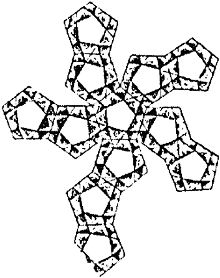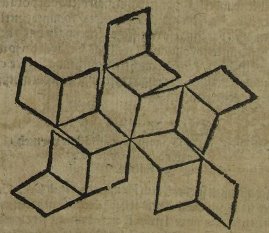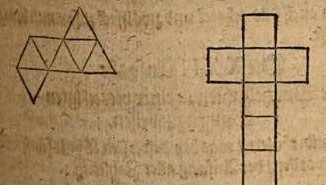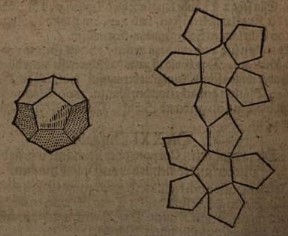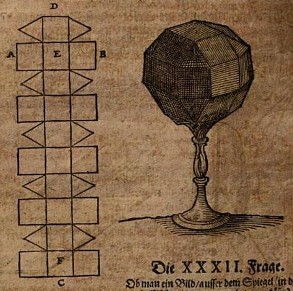| The Public Paperfolding History Project
Last updated 31/12/2025 x |
|||||||
| Foldable Nets for Polyhedra | |||||||
| This
page is being used to collect information about the
history of Foldable nets for Polyhedra. Please contact me
if you know any of this information is incorrect or if
you have any other information that should be added.
Thank you. Note that this page only shows early instances of the use of this technique. There is a separate page about The Froebelian Occupation of Constructing Polyhedra from Irregular Nets after the death of Froebel in 1852. ********** 1509 According to Max Stech in his book 'Dürers Gestaltlehre der Mathematik und der bildenden Künste (Dürer's Gestalt Theory of Mathematics and the Fine Arts), published by Halle an der Saale in 1948, a 1509 Venetian edition of 'Divina Proportione' by Luca Pacioli and illustrated by Leonardo da Vinci contains a drawing showing the foldable net of a regular dodecahedron. (Information from 'A History of Folding in Mathematics by Michael Freedman, published by Birkhauser in 2018.) I have not been able to verify this information.
********** 1510 Charles de Bovelles (variously also known as Carolus or Bovillus) book 'Libellus de Matematicis Corporibus', published in 1510, included drawings of polyhedral nets for an icosahedron ( in three parts) and a fifteen sided solid constructed by adding pyramids to the pentagonal faces of a pentagonal prism. (Information from 'A History of Folding in Mathematics by Michael Freedman, published by Birkhauser in 2018.) I been not able to verify this information. ********** 1525 The fourth book of Albrecht Durer's 'Unterweisung der Messung', published in 1525, contained foldable polyhedral nets for the five platonic solids, the truncated tetrahedron, the cuboctahedron, the truncated octahedron, the truncated cube, the rhombicuboctahedron, the truncated cuboctahedron, the snub cube and an eighteen sided solid made by adding pyramids to both hexagonal faces of a hexagonal prism.
********** Foldable Polyhedral Nets also appear: 1570 In The Elements of Geometrie by Henry Billingsley.
********** 1636 In 'Deliciae physico mathematicae oder mathematische und philosophische Erquickstunden' by Daniel Schwenter, which was published in Nürnberg in 1636, contained a net for the Rhombic Dodecahedron and a half net for the Triacontahedron.
********** 1651 In Volume 2 of 'Deliciae physico mathematicae' written by Georg Phillip Harsdorffer, and published in 1651 gave cut and fold nets for the cube, octahedron and dodecahedron.
********** 1653 In Volume 3 of 'Deliciae physico mathematicae' written by Georg Phillip Harsdorffer, and published in 1653 gave a net for the rhombicuboctahedron (although the net is incorrect as it is ten segments, rather than just eight, in height).
.********** |
|||||||
